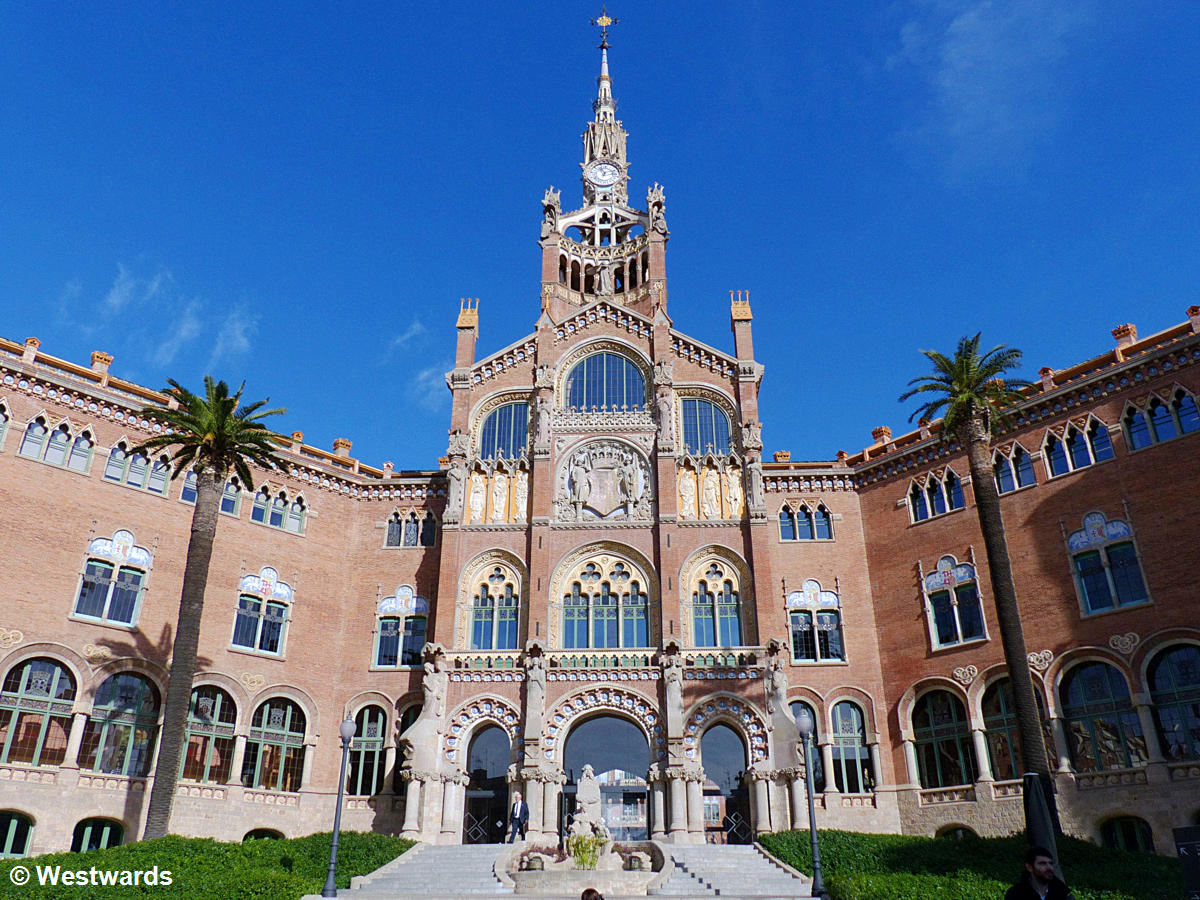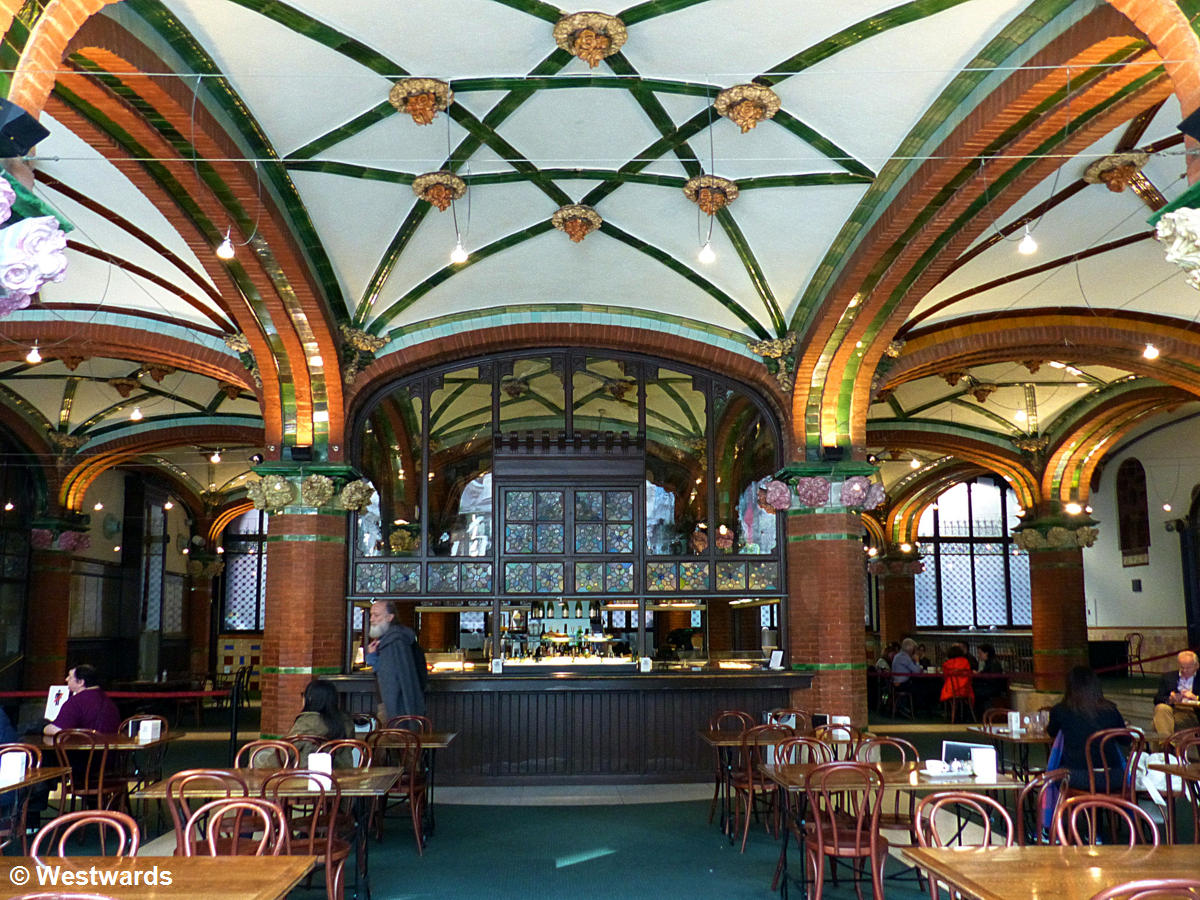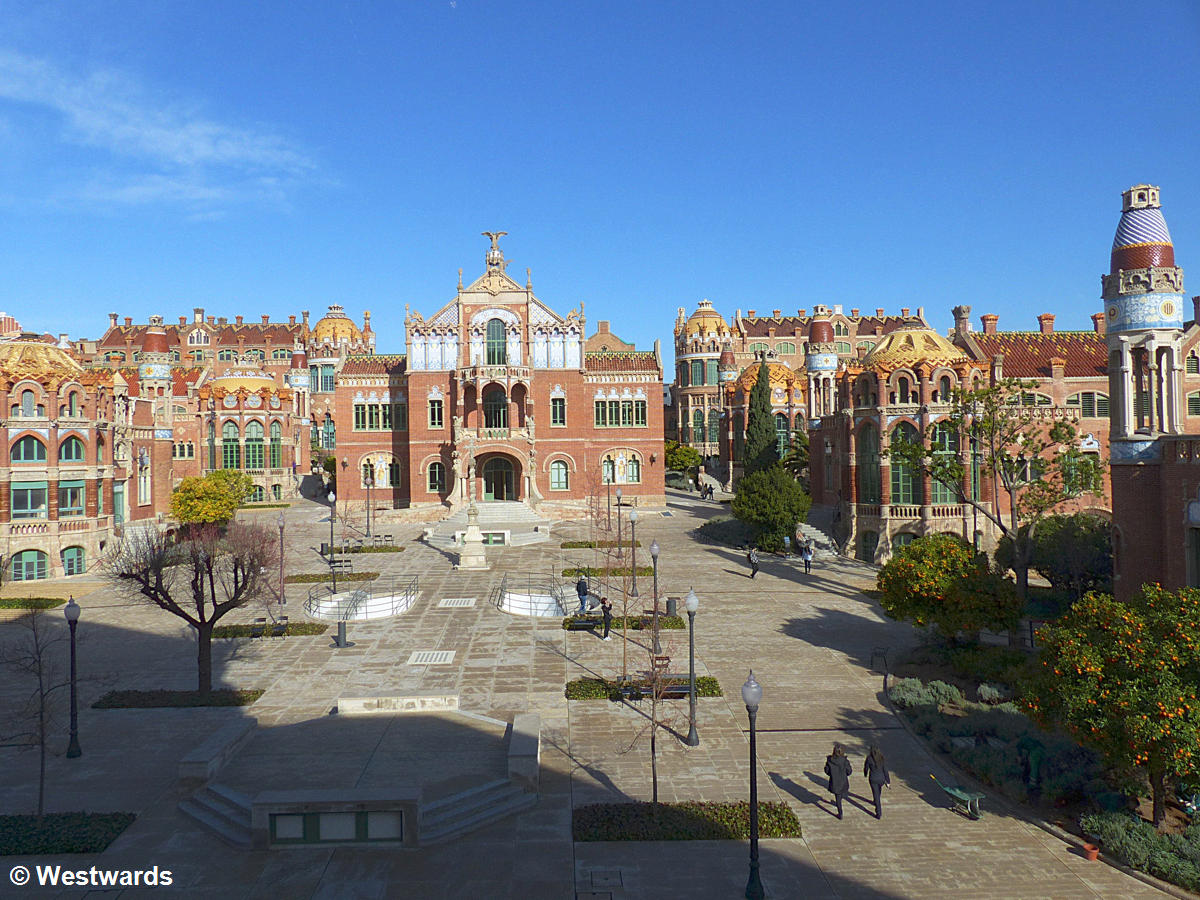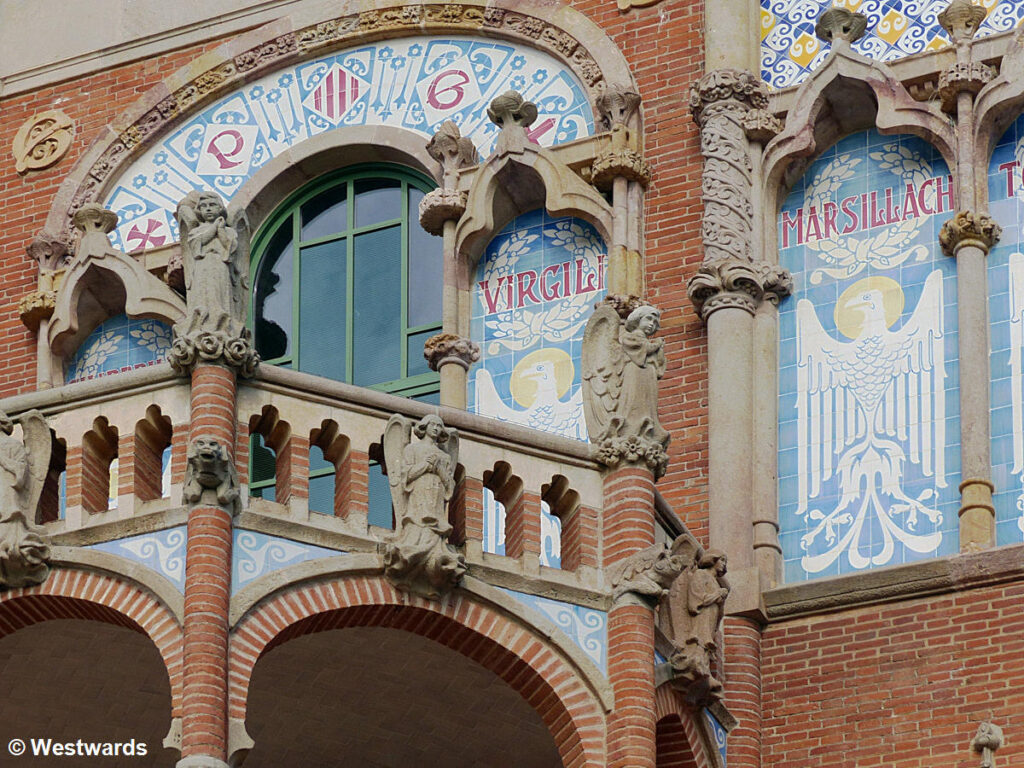
On our short visit to Barcelona we explored some beautiful architecture. Among our architectural Barcelona highlights were the Palau de la Musica and the Hospital de San Pao. Sure, the most famous Spanish architect from Barcelona is Antoni Gaudi. But these two modernist buildings were both built by Lluís Domènech i Montaner – another great architect of Barcelona.
“Gaudí was run over by a street car in 1926,” we read in the guidebook. The famous architect of Modernisme in Barcelona, who built the Sagrada Familia and coined the very style of art deco in Spain, subsequently died in the city’s Paupers’ Hospital. Gaudí had spent all his income on this dream of a church. But the medics didn’t even recognised Gaudí – and that old hospital was a shithole of a place apparently.
Lluís Domènech i Montaner – an architect for the people
The real tragedy is however that Barcelona’s old hospital was in the process of closing down! The city had decided to replace it by a brand-new, state-of-the-art institution not so far from Gaudí’s Sagrada Familia. In 1926, the new hospital San Pau was already working. And only a year later, the mediaeval place in the city centre closed for good. The new hospital’s architect was Lluís Domènech i Montaner. Montaner was a much respected architect, and in his time much more famous than Gaudi himself. Born in Barcelona, he initially studied physics and natural sciences, but soon successfully switched to architecture.

The Palau de la Musica
Montaner also built the impressive Palau de la Música Catalana in the city centre. The “Palace of Catalan Music” was a concert hall purpose-built for a local choral society that was also at the forefront of Catalan nationalism. Particularly the huge stained-glass windows and the large coloured skylight are breathtaking. Soon the Palau de la Musica became a milestone of Catalan Art Deco style. This Spanish architecture and design trend is close to the Arts and Crafts Movement, Jugendstil, and Art Nouveau. In Spain it is also called Modernisme.

A new state-of-the-art hospital
Of course we did visit the Palau de la Música – after some of the must-see Gaudí attractions. But on our last day, we were not so keen to spend more money and time on Gaudí buildings. Instead, we decided to visit one of the (as yet) lesser-known architectonic innovations of Modernisme – the Hospital de la Santa Creu I Sant Pau. Thanks to a very generous bequest by the banker Pau Gil, Montaner could build with the best materials and good artisans, on a huge plot of land. For each patient in the new hospital, he had almost 150 square meters of land!

The Hospital de San Pau still exists today, albeit as a huge new and modern health institution. From the metro station by the same name, we have to walk around the whole quarter to the opposite corner. There the original entrance hall with some of the modernist buildings are still standing. They have been restored after decades of use, alterations and decay.
Colourful mosaics depicting scenes from the municipal hospital’s history since the middle ages adorn the facades of the administrative building. Through grand stairways, lounges and halls we get into the spacious garden.

Montaner’s design included some taller main buildings and numerous smaller pavilions. The spacious gardens around should support the convalescence of the patients. The architect had previously worked at the construction of a mental health facility. At the time this was a new field of medicine with a broader approach to healing. Accordingly, he wanted to use materials such as ceramics and natural stones that were both hygienic and pleasant and calming to see and feel. The patients’ areas were decorated with patterned tiles, carvings, mosaics and the like.
New hygienic standards
On the other hand, medical facilities in the Hospital de San Pau were strikingly sober and uncluttered. The operating theatre is a semicircular room with enormous glass windows over the entire northern front. Montaner designed it for a maximum of space and natural light. All the hospital buildings spread out over the flowering gardens. Montaner built a tunnel connecting all the medical and chirurgical facilities. The tunnel not only contained supply lines but also served to move patients hygienically between buildings.

We spent more than 2 hours in the restored historic hospital, which became a UNESCO World Heritage site in 1997, along with the Palau de la Música. In spite of its decorative playfulness, the architecture appears rational and purposeful. Here, it seems, Gaudí might have survived his accident…
Is it worth visiting the Palau de la Musica and Hospital de San Pao?

To get into the famous concert hall and the interior rooms of the Palau de la Música, you have to join a tour. So that is what we did. Unfortunately there was a concert for children being staged in the main hall and we could only visit parts of the concert hall.
Moreover as there is a dense schedule of architecture tours, you have to stay with the group the whole time. That means you can’t go back to a place you liked. Although the Palau de la Música is nice enough, we found that the Hospital San Pao was a real architectural highlight (not only of Barcelona, but of our travels in general).
For entrance fees and opening hours see Palau de la Música and Hospital San Pao.
Did you visit the Palau de la Musica and Hospital de San Pao in Barcelona? What was your impression?
If you like this type of architecture and design, read also about our travels to Glasgow. We spent a day there in the footsteps of the famous Scottish architect Charles Rennie Mackintosh.
We did get free entrance tickets with our press card – all other expenses of our Barcelona travel we paid ourselves.
Never miss a new post! Get notifications about new posts straight into your inbox!


This brings back such beautiful memories. I made a quick day trip to Barcelona and visited only very few places and these 2 places – Palau de la Musica and the Hospital de San Pao – were definitely there. It was funny because I actually went to the modern, functional hospital and asked where is the historic site and they handed out a map to me! Apparently many had reached there looking for this place! Haha. I was indeed fascinated by the Operation Theatre. The natural lights & galleries for others to observe is all very intelligent design.
Dear Bushavali, we also went first to the modern hospital, but eventually found the right entrance!
We are heading to Barcelona in April and were just starting to make our plans. So seeing this post on Palau de la Musica and the Hospital de San Pa gave me a new idea. A different view of the architecture of Barcelona than we have got from visiting Gaudi sites. Good to know we need to join a tour to see the inside rooms.
Dear Linda, the tour is only necessary for the Palau de la Musica. You can explore all parts of the Hospital de San Pao on your own.
You are right – everyone has heard of Gaudi but this one introduces me to an equally brilliant architect. Loved the perspective and the history that you have shared about these buildings. Those mosaics that depict the history of the place – now that would be very interesting to see.
Dear Ami, thanks for your comment and kind words. If you are intrested in modernist architecture I would advise a visit to the Palau de Musica and Hospital de San Pao.
I remember passing by this building when in Barcelona and be intrigued by its architecture but never knew about its history and that you could tour the inside. Barcelona is such a great city for architecture that I loved going from building to building admiring the different styles. This is one that stood out for me.
Dear Renee, I guess you mean the Palau de la Musica? The other buidling mentioned in the post is the Hospital de San Pao, which is a bit out of the way.
I adore the modernism architecture in Barcelona and have visited Hospital de San Pao. I’m always surprised more people don’t know about it. I have not had the opportunity to see Palau de la Música, it sounds like a bit of bummer to schedule and stay with the group.
I’m impressed with the hospital building. I wonder how does it look like inside the patient rooms though. But not so with the concert hall as a lot of today’s buildings built like that. Beautiful, but not too impressive.
Barcelona is a stunning city with a diverse range of architectural features to enjoy. The Hospital de San Pau’s design is truly distinctive, and I absolutely love it. I wouldn’t guess it’s a hospital simply in the photographs; it looks like more of a theme park. Architect Montaner deserves the credit for his work. Two enthusiastic thumbs up!
What a stunning architectural masterpiece! A feast for the eyes, indeed! I have a sweet spot for structures that integrate culture, heritage, and modernism in the elements.
Happy to know that Hospital San Pao is worth visiting. It’s also great that it is now considered a UNESCO World Heritage Site. We’d love to visit in the future.
Barcelona’s modernist architecture is stunning, and I also really enjoyed the Palau de la Musica and Hospital de San Pao. However, I remain a huge fan of Gaudi. I like the colorful mosaics on the hospital and this vast space. I want to buy a ticket for some classical or flamenco concerts at the Palau de la Musica one day, as it must be a fantastic experience. Its huge stained-glass windows are beautiful as well.